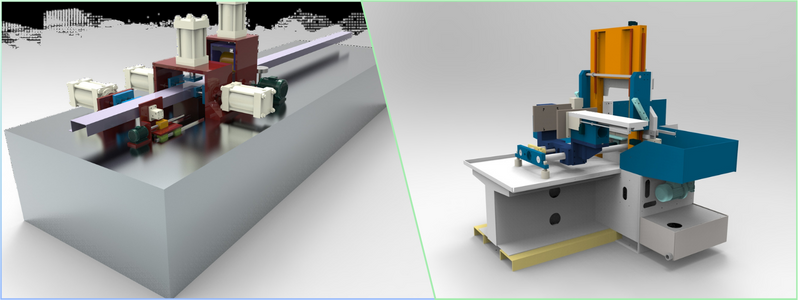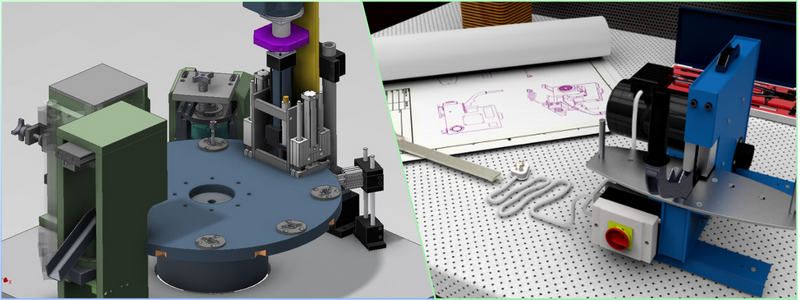This article covers PLC programming and automation services, rates, costs and pricing for companies. Most consumer goods are manufactured at large-scale production facilities with massive industrial machines. Robotic arms with various mechanical attachments line up along extensive conveyor belts and perform their duties without a single human operator nearby. The absence (or at least minimal presence) of human workers is an old concept.
Benefits of PLC programming
Machines can perform repetitive tasks quicker, more consistently, and at a higher degree of accuracy than humans. Also, robots do not suffer from fatigue or injuries due to exhaustive work. All those machines, however, can only perform well and as intended thanks to human-made computer-controlled systems. Industrial automation has been around since the late 1930s, with mechanical principles consisting mostly of hydraulic and pneumatic systems, starting with automobile manufacturing companies in Japan.
Other countries soon followed suit, and now we have arrived at a point where automation is the backbone of the manufacturing industries. With the help of PLC programming services, computerized mass production eliminates the chances of human error, reduces labor costs, and increases output in less time. Industrial automation is not a set-and-forget gadget but most likely a sophisticated system comprised of multiple devices integrated into a single, configurable process.
RELATED: Benefits of outsourcing CNC machining services for your company’s prototype design
PLC (programmable logic controller)
There are several methods/platforms with which manufacturers can implement automation. PLC programming services are one of the oldest and most common of them all. It was first used in 1968, invented by Dick Morley for General Motors. PLC resembles a large-size industrial computer encased in a ruggedized shell. It comes with modular components pre-programmed to monitor a broad range of manufacturing equipment.
Automation happens when the components receive inputs from sensors or connected devices, process the information, and trigger output commands to the corresponding industrial machinery. Inputs can be manufacturing parameters or milestones, whereas outputs are control schemes that determine any subsequent actions for the machines to perform.
Everything is customizable, from sensors and parameters to manufacturing capacities and troubleshooting sequences. For example, PLC can be relatively small if it connects only to a limited number of machinery in a moderate factory. Sometimes, PLC is massive enough that the computer requires an entire floor space. Think of it as a manually-programmed IoT (Internet of Things) workstation with the ability to configure the behaviors of all output devices based on the data received from input sensors.
RELATED: Top 100 electronics design companies to create prototypes for hardware startups
Cost-effective solution
In the old days, industrial automation used relay-based systems following the proliferation of transistors. Large manufacturing equipment had an electrical panel to control hundreds (if not thousands) of mechanical relays. PLC was born as a logical improvement over its predecessor. Instead of installing a relay box in every industrial machinery to control its functionality, using a computerized system capable of real-time monitoring and integrating the manufacturing process is easier and more practical.
when you compare relay-based automation with PLC, the latter is more cost-efficient to run and maintain. It is also less prone to mechanical wear yet more configurable and can handle more complex tasks. PLC can constantly monitor large-scale operations without interruption as long as it is plugged in, just like any regular home computer. Unless a production facility implements significant changes to the manufacturing process—that require reprogramming—PLC may operate indefinitely with minimum human input.
RELATED: Top 10 industrial design software packages for companies

How PLC programming works
PLC also refers to the ecosystem within industrial automation. It is more than just a piece of hardware but an integrated system built of software packages and hardware resources that work together under the programming language. Some popular PLC ecosystems include SIMATIC by Siemens (the standard option in most European and Asian regions) and Allen Bradley by Rockwell Automation (primarily used in North America).
As briefly mentioned earlier, PLC programming works by receiving and processing information from input devices and then translating the information into commands to control output devices. Based on the PLC programming parameters, the system can record run-time data and monitor performance. For example, a PLC can reduce the manufacturing load of a machine in case the temperature nearly exceeds a safe threshold, or it may automatically start and stop a process each time the sensor finds a malfunction. Manufacturers design PLCs to be modular, meaning a company may easily connect, disconnect, expand, or scale down the capability.
RELATED: 50 Excellent tools for freelance industrial designers and engineers
The following three major features set PLC apart from alternative industrial automation control options:
- I/O (Input/Output): the main CPU in a PLC system stores the programming data. It connects to all other devices, such as manufacturing equipment, through various I/O modules. Input modules may include switches and sensors. They can be either digital or analog. Output modules are relays, valves, lights, and propulsion mechanisms like drives. A manufacturing facility can use compatible measuring units and output devices to achieve the desired automation.
- Communications: PLC offers a broad range of communication protocols and ports to connect to other systems, such as supervisory computers. In the manufacturing automation paradigm, PLC is a “level 1” operation directly controlling connected devices. At “level 2” is supervisory computers, commonly called SCADA (supervisory control and data acquisition) systems, providing remote access to PLC.
- HMI (human machine interface): in an integrated system consisting of PLC and SCADA, the HMI allows users to review and override the pre-programmed controls. It can be a conventional text-based interface using a keypad or touchscreen panel.
Apart from the modular PLC that a large manufacturing facility typically uses to connect and control dozens of machinery, there are also compact options with a fixed number of allowed inputs and output devices. Regardless of the types, all PLCs share common goals of easy deployment, high reliability, and flexible configurations.
RELATED: Top 101 engineering and mechanical design firms in the United States
How is a PLC programmed
Early PLCs were relatively simple compared to their modern iterations. They have evolve and became much more sophisticated due to the increasingly complex manufacturing demands. Despite all the changes and modernizations, one thing remains unchanged: PLC is a critical component that industrial design firms use in industrial automation. Because it manages how different industrial machinaries work and interact with each other, the control system must allow for a variety of trigger mechanisms as well. It could be a simple push of a button, a series of switches in complex equipment, or a start/stop sequence of a motor.
An embedded program assembles the control structure in the proper order based on logical sequence, hence programmable logical control. It takes a professional computer programmer or PLC programmer, preferably one specializing in industrial and manufacturing applications, to configure and optimize a PLC system per specific project requirements and business needs. In simple terms, PLC programming refers to all activities for designing, testing, and implementing the automation control structure of manufacturing equipment.
RELATED: Manufacturing services and tool design engineering

PLC programs
Some PLC programs contain text-based computer commands, while others use visual/graphical representations of the logical control sequence for various types of machinery used in industrial applications. Most PLC software packages use the traditional “ladder logic” programming language. Ladder logic is graphical, making it easier to configure than its text-based alternative. A PLC has terminals for inputs and outputs with “control logic” establishing the relationship between them. Inputs are parameters, whereas outputs are actions.
PLC programming involves designing a logical connection to ensure that each specific parameter creates a command to execute a corresponding action. A PLC programmer may use a desktop computer, laptop, or proprietary handheld programming device (which connects to the controller via cable) to enter a new program or modify an existing one. Handheld devices are compact and portable but do not typically have the range of features and programming software installed on a computer.
RELATED: How computer-aided design (CAD) services are used by engineering firms
Programming procedure
In most cases, the programming procedure follows the same basic steps. Once you create a new program, the software offers the option to check for errors through simulation in “offline” mode. Being in offline mode means running the program without affecting any connected devices. A PLC programmer should fix any mistake (if any) before running another simulation. When it is ready, he will download the program to the PLC and activated.
PLC Programming rates
Professional PLC programmers are computer programmers specializing in programming languages for industrial machinery or manufacturing equipment. PLC programmers write, test, and modify codes or scripts to ensure that computers and all the connected machinery work together as intended. PLC programmers must be able to transform a design of a sequential manufacturing process made by engineers into a set of instructions that a PLC can follow and execute. They can write programs for assembly lines, robotic arms, warehouse shipping/inventory, and manufacturing equipment for the mass production of consumer goods.
RELATED: What are industrial design rates & costs at product design services firms?
Average wage of PLC programmers
The average annual wage of PLC programmers (full-time, employed in the manufacturing industry) in the United States is $98,000, or around $47 per hour. Freelancer rates vary widely from $37/hour to $150/hour, depending on qualification, experience, and job requirements. At the higher end of the spectrum, an employer can expect to hire a professional PLC programmer with more than a decade of experience in the industry with the ability to troubleshoot even the trickiest control logic in a large-scale manufacturing facility.
| PLC Programmer Rates | |
|---|---|
| Experience Level | Hourly Rate Range ($) |
| Entry Level | $37 – $47 |
| Mid-Level | $47 – $90 |
| Senior Level | $90 – $150 |
Please note that these rates are approximate and may vary depending on various factors such as location, demand, project complexity, and negotiation skills.
How Cad Crowd can assist
It takes a lot of work to get from a concept to a product, and a lot goes into succeeding in the market than simply coming up with a good idea. Various factors need to be considered that go beyond the product’s essential functionality, which involves ergonomics, aesthetics, manufacturability, durability, ease of use, and production price. Cad Crowd has a network of designers and product developers who can assist you through the design and development process. Contact us today for a free quote.
